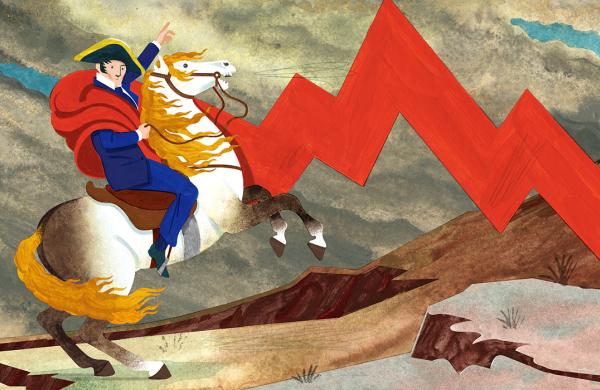National Grid, the biggest utility in the U.K., where it distributes natural gas to some 12 million customers, has spent much of the past decade balancing that business by strengthening its foothold across the Atlantic. In contrast to its counterpart ScottishPower, which bought West Coast utility PacifiCorp in 1999 and sold it in 2006, National Grid has gotten in deeper. It paid more than $7 billion in cash last August for Brooklyn, New York–based KeySpan Corp. to become the biggest utility in the Northeast and second in the U.S. in number of customers, behind California’s PG&E Corp.
That strong presence at the heart of the energy infrastructure on two continents means that issues related to carbon emissions and global warming land squarely on National Grid CEO Steve Holliday’s doorstep. He’s confronting them head-on: In April the London-based company raised its corporate target for reducing greenhouse gas emissions by 2050 from 60 percent below 1990 benchmark levels to 80 percent. Some of that is a stretch. “We have a plan to get to 65 percent” from the current 38 percent, says Holliday. “I don’t know what will get us the remaining 15 percent. That’s why we set the target.”
By his actions, then, Holliday is on the climate-change bandwagon, pledging to “ensure that emissions reductions remain at the heart of our operational decision making.” But he also hopes to assert leadership in another way, by counseling moderation to regulators and government officials, asking them and their increasingly green-conscious constituents not to get carried away with eco-enthusiasm.
“You can set an aggressive target, like having 20 percent of power coming from renewables by 2020, but let us work out what is feasible before committing to something that is undeliverable,” Holliday, a former Exxon Corp. executive who joined National Grid in 2001 as group director for the U.K. and Europe in 2001 and has been CEO since January 2007, tells Institutional Investor. That’s exactly the message he says he has been sending the U.K. government, which on June 26 set a goal of 15 percent renewables by 2020 in what Prime Minister Gordon Brown called “the most dramatic change in our energy policy since the advent of nuclear power.” National Grid, owner of the U.K.’s transmission system for electricity, currently at 5 percent renewables, deems that target achievable.
“I think we have a real obligation, because of the business we are in, to help people think through the complexities to make this happen,” says Holliday, 51. Besides tackling environmental issues, the CEO has overseen a series of acquisitions and divestitures that led to an operating profit increase of 28 percent, to £2.6 billion ($5.2 billion), in the fiscal year ended March, on a 31 percent rise in revenue, to £11.4 billion. He discussed National Grid’s strategy and growth plans with II U.S. Editor Jeffrey Kutler.
Institutional Investor: What motivates your stance on climate change?
Holliday: As individuals, our management team believes strongly that we want to do something. As a business, we have an opportunity to help educate customers and work with the rest of our industry as it goes through what can only be described as a huge transformation. In ten years this industry will look nothing like it does today. We are at the heart of that and can take a position in the debate, working with policymakers and regulators to navigate the course as the industry restructures itself.
Where do some people get it wrong?
We have to look at how to restructure the wires and pipes of this industry to make sure we still have reliability. The best example of that is wind power: It is very green, but also unreliable. The most efficient wind farms in the world have load factors of 40 percent, and many are as low as 20 percent. That means you need another source at least 60 percent of the time, and that’s an entirely different world for managing electricity systems from what we have today. It’s absolutely feasible, but we need a master plan to get there by 2020 or 2030.
Will that issue play out the same way in the U.S.?
We’ll know more after the November elections, but our industry is fundamentally regulated at the state level, and some federal-level umbrella would be very helpful. That said, all the states we are in are part of the Northeast regional greenhouse gas initiative.
What is your history in the U.S.?
National Grid started by acquiring New England assets in 1999 and 2000, followed in 2001 by Niagara Mohawk in New York State. Half our business now is in the U.K., and half is in the U.S. Also, half our business is gas and half is electricity.
Is there a strategic logic for being in only these two countries?
We know we can grow through a lot of investment in these markets in the coming years, and the U.S. requires more investment in utilities than any other country, including China. The logic was slightly different for my predecessors. As of 1999, they were looking to grow in multiple markets. They had invested in Argentina, Brazil, Chile and Zambia — businesses that were subsequently sold, as was a wireless business. The refocusing that we laid out at the end of 2006 was driven by a macro view of the huge challenges that utilities face worldwide, the massive investments required to replace infrastructure and the need to “green up” the energy supply over the next ten years.
Have you stepped up U.S. investment?
We are investing at a rate that our business has never invested at before: £16 billion from 2006 to 2012. The vast majority of that is going to the U.K. Of £3 billion this [fiscal] year, £1 billion is in gas distribution, about one third of that in the U.S., and £1.3 billion is in gas transmission, only a small fraction of that in the U.S. Another £500 million is mainly for tripling the size of our Isle of Grain, Kent, liquefied natural gas facility. By winter 2010 we will have the capacity to import 22 percent of the U.K.’s gas. But we are spending only £200 million on U.S. electricity distribution and generation because current regulatory arrangements don’t incentivize investments at the level they need to be.
Are you lobbying to get the regulatory incentives that are now lacking?
We have a duty to make sure regulators and policy-makers understand why we want to make these investments and why it is worth it for customers to pay for these investments based on the benefits that will accrue to them over a long period of time. There is an asymmetry of information here. We manage these assets, have thousands of engineers, and are in a strong position to say what needs doing. We can’t deliver U.K. levels of reliability in the U.S. today because of the condition of the electricity assets there. Some in New York date back to the 1920s and have to be renewed.
You have targeted $100 million in “synergy savings” from the KeySpan merger. Does that come only out of U.S. operations?
The KeySpan synergies are literally about putting two businesses in the U.S. together, and they are mostly behind the scenes: in information technology, corporate services and the back office. We reduced 1,700 positions out of 18,000 total U.S. employees, all through attrition. (The U.S. workforce outnumbers the 10,500 in the U.K.) Out of the $100 million, we promised $50 million by March 2009, and we were at $38 million by March 2008. More broadly, out of a cost base of $4 billion, we can “globalize” 45 percent related to processes. Another one third relates to standardizing lines of business: A gas job is a gas job.
Does your $34 billion market cap put you in a position to consider more acquisitions?
Our investment story is to grow this business organically through the investments we are making. Growth in profits and the dividend over the next five years is not predicated on buying something else. Do I believe that there will be more consolidation in this industry in the U.S.? Yes. We would obviously be keen to play a part in that, but it’s not central to what we are about today. Europe is very much a closed market because of the structure of the industry. There has been a change over the past six months involving the potential sale of wires by the big German utilities. If that happens, we will certainly have a look at those assets. But I stress the words, “have a look.” Our ability to create value and get regulatory certainty are two big questions.
Do investors buy into your long-term thinking?
An investor will want to know if there is a downside — will the business implode or a technology come along that destroys the business model? The answer is no. Our challenge is to get the equity market to understand just how low-risk this business is and how low our cost of capital really is.





